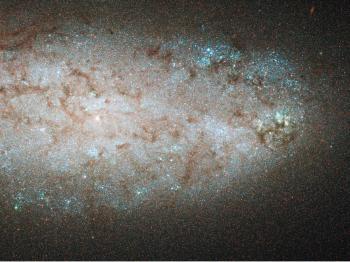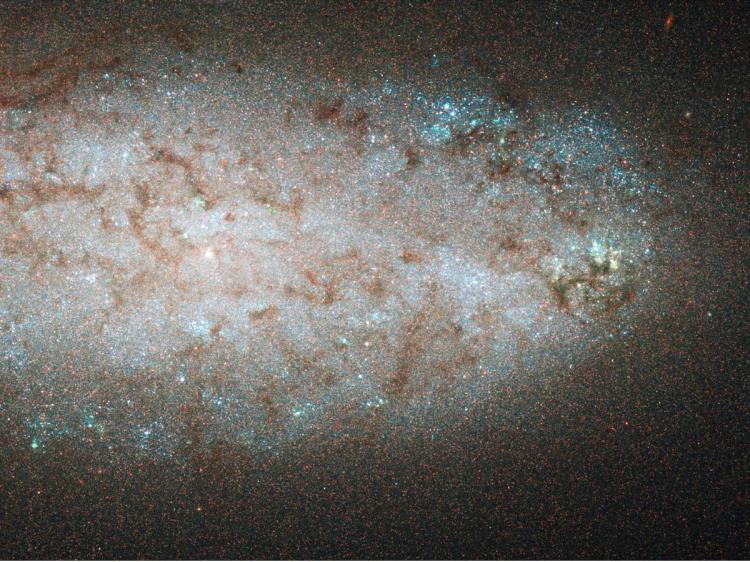Images from the Hubble Space Telescope showed what seems to be the end of the star creation process for a relatively small spiral galaxy 12 million light-years away from Earth. It is the dwarf Galaxy NGC 2976 of the M81 Group, a galaxy cluster in the constellation of Ursa Major, close to the Local Group. The Local Group is a cluster of galaxies including the Milky Way.
This recent discovery has puzzled scientists, since the M81 Group is characterized as possessing a high amount of starburst activity (or the formation of many stars). This kind of activity usually happens after a close encounter between two galaxies or when they collide.
Scientists still have not fully understood the intricate mechanisms involved in star formation, but it is believed that nearby interactions between galaxies can cause unstable rotations, which cause gas to move toward the nucleus of the galaxy. The gas then concentrates on the nucleus and ignites bursts of star formation.
NGC 2976 might have interacted with bigger galaxies about 500 million years ago, which cut off the concentrations of gas in it, causing part of the gas to go out of the galaxy and the rest to go in to the core.
The gas concentrations in the outer layers of the galaxy have now stopped generating new stars, but star birth activity at the core is still prominent.
Even though NGC 2976 is considered a spiral galaxy, its structure is rather uncommon as it lacks spiral arms and doesn’t have the central shape that galaxies of its type tend to have.
“The galaxy looks weird because an interaction with the M81 Group about a billion years ago stripped some gas from the outer parts of the galaxy, forcing the rest of the gas to rush toward the galaxy’s center, where it has little organized spiral structure,” said Dr. Benjamin Williams, astronomer at the University of Washington in Seattle and director of the Hubble study, in a press release.
Even though NGC 2976’s case is quite rare, Dr. Williams believes there are dwarf galaxies that have been affected in similar ways by nearby galaxies. However, it is yet to be proven that this phenomenon is common unless the Hubble Telescope can locate another dwarf galaxy in similar conditions to be examined.
Read the research paper at http://arxiv.org/abs/0911.4121
This recent discovery has puzzled scientists, since the M81 Group is characterized as possessing a high amount of starburst activity (or the formation of many stars). This kind of activity usually happens after a close encounter between two galaxies or when they collide.
Scientists still have not fully understood the intricate mechanisms involved in star formation, but it is believed that nearby interactions between galaxies can cause unstable rotations, which cause gas to move toward the nucleus of the galaxy. The gas then concentrates on the nucleus and ignites bursts of star formation.
NGC 2976 might have interacted with bigger galaxies about 500 million years ago, which cut off the concentrations of gas in it, causing part of the gas to go out of the galaxy and the rest to go in to the core.
The gas concentrations in the outer layers of the galaxy have now stopped generating new stars, but star birth activity at the core is still prominent.
Even though NGC 2976 is considered a spiral galaxy, its structure is rather uncommon as it lacks spiral arms and doesn’t have the central shape that galaxies of its type tend to have.
“The galaxy looks weird because an interaction with the M81 Group about a billion years ago stripped some gas from the outer parts of the galaxy, forcing the rest of the gas to rush toward the galaxy’s center, where it has little organized spiral structure,” said Dr. Benjamin Williams, astronomer at the University of Washington in Seattle and director of the Hubble study, in a press release.
Even though NGC 2976’s case is quite rare, Dr. Williams believes there are dwarf galaxies that have been affected in similar ways by nearby galaxies. However, it is yet to be proven that this phenomenon is common unless the Hubble Telescope can locate another dwarf galaxy in similar conditions to be examined.
Read the research paper at http://arxiv.org/abs/0911.4121






